Introduction
Although the entry-level full-frame Nikon D600 was a hugely popular model it was not without some technical issues. While not officially recognized as a fault by the firm, users commonly reported oil spots and dust on the sensor after a period of use. A service advisory was announced outlining methods to clean the sensor, but the firm didn’t go so far as to disclose the reason behind the problem. Whether by coincidence or design, within a year Nikon announced a minor update to that model, resulting in the Nikon D610.
While there was no mention of a remedy to the initial issues, curiously, the D610 features an enhanced shutter mechanism with a new quiet 3fps burst shooting mode and a slightly higher maximum continuous framing rate of 6fps (up from 5.5fps). Nikon also revised the white-balance metering system to improve color accuracy in artificial lighting. In almost every other respect though the D610 shares the same features as its popular predecessor.
Our labs have evaluated the optical characteristics of 95 different lenses on the camera from both Nikon and third-party makers. We’ve analyzed 41 zooms in total, recently adding two Sigma models, the new high-grade 120-300mm f2.8 EX and the older consumer-oriented APO 70-300mm f4-5.6 Macro Super II.
Out of the remaining 54 fixed focal length lenses, we’ve had the opportunity to include the new Nikon AF-S Nikkor 58mm f1.4G as well as well as the older Nikon AF Nikkor 14mm f2.8D ED and 180mm f2.8D IF-ED models. We’ve also added the highly regarded Sigma APO Macro 150mm f2.8 EX DG OS HSM to our database.
Intriguingly, the sharpness scores between the D600 and D610 aren’t exactly the same, as you might expect, in fact the newer model shows some small improvement. Although the results are never more than 10% in favor of the D610, the evidence suggests Nikon has likely reduced the strength of the AA filter making something more to like about the Nikon D610 than the few official updates.
As with the earlier Nikon D600, the rankings remain similar though the DxOMark scores and Sharpness scores tend to vary slightly. Take the best performing prime lens, for instance, it has a slightly lower DxOMark score of 39 points (vs. 40 with the D600), but it has a Sharpness score of 21P-Mpix (+1) and is just one point behind the Sharpness score of the 36-Mpix D800 when measured with that lens. There are several other cases where that’s repeated, including the Sigma 35mm f1.4 where sharpness increased from 19P-Mpix on the D600 to 20P-Mpix on the D610.
 |
 |
 |
 |
| Nikon AF-S Nikkor 85mm f/1.4G | 2199 | 39 | 21 |
| Nikon AF-S Nikkor 200mm f/2G ED VR II | 5899 | 38 | 23 |
| Nikon AF-S NIKKOR 85mm f/1.8G | 690 | 38 | 19 |
| Sigma 35mm F1.4 DG HSM A Nikon | 899 | 38 | 20 |
| Carl Zeiss Makro-Planar T 100mm f/2 ZF2 Nikon | 1840 | 35 | 17 |
| Samyang 85mm f/1.4 Aspherique IF Nikon | 328 | 35 | 17 |
| Carl Zeiss Distagon T 25mm f/2 ZF.2 Nikon | 1700 | 34 | 20 |
| Nikon AF-S Nikkor 400mm F2.8G ED VR | 8999 | 34 | 22 |
| Nikon AF-S Nikkor 24mm f/1.4G ED | 2200 | 33 | 17 |
| Samyang 35mm F1.4 AS UMC Nikon | 599 | 33 | 15 |
| Sigma 85mm F1.4 EX DG HSM Nikon | 969 | 33 | 18 |
| Nikon AF-S NIKKOR 300mm f/2.8G ED VR II | 5900 | 33 | 21 |
| Carl Zeiss Distagon T 35mm f/1.4 ZF2 Nikon | 1843 | 33 | 17 |
| Nikon AF Nikkor 85mm f/1.4D IF | 1230 | 32 | 16 |
| Carl Zeiss Distagon T 35mm f/2 ZF2 Nikon | 1005 | 32 | 18 |
| Nikon AF-S NIKKOR 35mm f/1.4G | 1797 | 32 | 16 |
| Nikon AF-S NIKKOR 28mm f/1.8G | 699 | 32 | 20 |
| Nikon AF Nikkor 50mm f/1.4D | 329 | 31 | 16 |
| Nikon AF-S Nikkor 50mm f/1.4G | 448 | 31 | 16 |
| Sigma 50mm F1.4 EX DG HSM Nikon | 499 | 31 | 16 |
The rankings look a little different for zoom lenses mainly on account of the new models added to our database. Neither the Tamron SP 70-200mm f2.8 Di VC USD nor the new version of the Sigma 120-300mm f2.8 DG OS HSM model was available at the time. However the stabilized Tamron SP 24-70mm f2.8 and Nikon’s AF-S Nikkor 24-70mm f2.8G ED, AF-S Nikkor 70-200mm f2.8G ED VR II and AF-S Nikkor 14-24mm f/2.8G ED all continue to do well, and even improve their scores very slightly on the new camera.
The AF-S Nikkor 85mm f1.4G stays at the top of the rankings in this category thanks to its high overall image quality and high-sharpness but the more modestly priced AF-S Nikkor 85mm f1.8G isn’t so far behind. Indeed there’s just one point in their respective DxOMark scores, which means image quality would be difficult to tell apart in real world use.
 |
 |
 |
 |
| Nikon AF-S Nikkor 85mm f/1.4G | 2199 | 39 | 21 |
| Nikon AF-S NIKKOR 85mm f/1.8G | 690 | 38 | 19 |
| Carl Zeiss Makro-Planar T 100mm f/2 ZF2 Nikon | 1840 | 35 | 17 |
| Samyang 85mm f/1.4 Aspherique IF Nikon | 328 | 35 | 17 |
| Sigma 85mm F1.4 EX DG HSM Nikon | 969 | 33 | 18 |
| Nikon AF Nikkor 85mm f/1.4D IF | 1230 | 32 | 16 |
| Nikon AF-S VR Micro-Nikkor 105mm f/2.8G IF-ED | 890 | 31 | 16 |
| Tamron SP 90mm F/2.8 Di MACRO 1:1 VC USD Nikon | 749 | 31 | 19 |
| Nikon AF Nikkor 85mm f/1.8D | 460 | 30 | 17 |
| Nikon AF DC-Nikkor 105mm f/2D | 1099 | 30 | 18 |
| Sigma 70mm F2.8 EX DG Macro Nikon | 499 | 29 | 14 |
| Carl Zeiss Planar T 85mm f/1.4 ZF2 Nikon | 1280 | 28 | 17 |
| Tamron SP AF 90mm F/2.8 Di MACRO Nikon | 460 | 28 | 15 |
| Sigma 105mm F2.8 EX DG OS HSM Nikon | 969 | 27 | 18 |
| Sigma 105mm F2.8 EX DG Macro Nikon | 640 | 27 | 17 |
The Samyang 85mm f1.4 Aspherical IF is another high-speed model that performs well optically but it doesn’t have the same uniformity at wider apertures as the two Nikon lenses and, don’t forget, it’s a manual focus only model.
Still, while it doesn’t have the corner sharpness of the two Nikon models that’s not so much of an issue for a portrait lens, and it does have good control of CA and vignetting. At just under half the price of the Nikon 85mm f1.8 model, it’s a seriously tempting option.
Several years ago standard primes like this weren’t particularly popular but as full-frame cameras have become more accessibly priced the 50mm is seeing a revival. Somewhat surprisingly, the older-film era AF-D Nikkor models continue to perform well on the D610 optically but, unless you really need a manual aperture collar, the newer models with their built-in ultrasonic-type motors and one-touch focus override features offer attractive improvements.
 |
 |
 |
 |
| Nikon AF Nikkor 50mm f/1.4D | 329 | 31 | 16 |
| Nikon AF-S Nikkor 50mm f/1.4G | 448 | 31 | 16 |
| Sigma 50mm F1.4 EX DG HSM Nikon | 499 | 31 | 16 |
| Nikon AF-S NIKKOR 50mm f/1.8G | 219 | 30 | 16 |
| Carl Zeiss Makro-Planar T 50mm f/2 ZF2 Nikon | 1280 | 29 | 17 |
| Nikon AF Nikkor 50mm f/1.8D | 134 | 28 | 17 |
| Nikon AF Micro-Nikkor 60mm f/2.8D | 460 | 27 | 18 |
| Nikon AF-S Nikkor 58mm f/1.4G | 1700 | 27 | 16 |
| Carl Zeiss Planar T 50mm f/1.4 ZF2 Nikon | 725 | 24 | 13 |
The AF-S Nikkor 50mm f1.4G performs similarly overall to the older AF-D model but it’s sharper at wider apertures and has improved uniformity throughout the aperture range. Not only that but Nikon improved the peripheral illumination and lowered chromatic aberration. When compared to the Sigma 50mm f1.4 EX DG, the Nikon can’t quite match the central sharpness at wider apertures nor the vignetting but it is more consistent across the frame and it has lower chromatic aberration overall.
It’s also good value at just under $450, especially if you compare the price to the new AF-S Nikkor 58mm f1.4G model.
While the new AF-S Nikkor 58mm f1.4G has extremely low chromatic aberration and a gradual fall-off in illumination at full-aperture its sharpness is a little low wide-open even in the center, though this improves significantly when stopped down.
For more results on the Nikon AF-S Nikkor 58mm f/1.4G, please click through to see our review Nikon AF-S Nikkor 58mm f1.4 G lens review: Premium performer?
Another good value model is the AF-S Nikkor 50mm f1.8G at just $219. It has similar center sharpness to the AF-S Nikkor 50mm f1.4 version but it has better uniformity and lower vignetting at wider aperture settings.
Topping the database for standard zooms is Tamron’s stabilized SP 24-70mm f2.8 Di VC USD model. At $1299 it’s not exactly inexpensive but it looks modestly priced next to Nikon’s equivalent AF-S Nikkor 24-70mm f2.8G ED model. Although it lacks stabilization the Sigma equivalent is good value, however, while the three lenses are close in our Sharpness scores they behave very differently.
 |
 |
 |
 |
| Tamron SP 24-70mm F2.8 Di VC USD Nikon | 1299 | 28 | 16 |
| Nikon AF-S Nikkor 24-70mm f/2.8G ED | 1800 | 27 | 15 |
| Nikon AF Zoom-Nikkor 24-85mm f/2.8-4D IF | 700 | 22 | 13 |
| Sigma 24-70mm F2.8 IF EX DG HSM Nikon | 899 | 22 | 16 |
| Nikon AF-S VR Zoom-Nikkor 24-120mm f/4G ED | 1300 | 22 | 13 |
| Tamron SP AF 28-75mm F/2.8 XR Di LD Aspherical [IF] Nikon | 499 | 21 | 13 |
| Nikon AF-S Zoom-Nikkor 24-85mm f/3.5-4.5G IF-ED | 299 | 21 | 14 |
| Nikon AF-S NIKKOR 24-85mm f/3.5-4.5G ED VR | 599 | 21 | 13 |
| Nikon AF-S VR Zoom-Nikkor 24-120mm f/3.5-5.6G IF-ED | 600 | 17 | 10 |
The main shortcoming with the Sigma is that while center sharpness is good at full aperture at the shorter end of the zoom range, it’s far from uniform across the field.
Other than that it performs quite consistently when stopped down to f4 and beyond, though both that and the Nikon have conspicuous chromatic aberration in the corners of the frame at their widest focal lengths.
All three have high levels of barrel distortion at the wider end, leading to pincushion at the long-end, though the Nikon has good correction at 70mm (though it’s noticeable between 35-50mm focal lengths).
If the high price and flexibility is a concern then the recently re-introduced and updated AF-S Nikkor 24-85mm f3.5-4.5G IF-ED VR model may be more suitable.
The previous non-stabilized version hasn’t been in production since 2006 but latest iteration comes very close in optical performance to its direct predecessor and has similar levels of sharpness to the older film-era, slightly faster AF Nikkor 24-85mm f2.8-4D version, which is still listed as being current.
If you have a Nikon D610 and a favorite lens, we would very much like to hear from you. Please leave a comment below, stating what lens it is and why you like it.


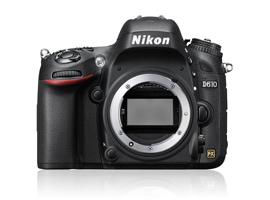
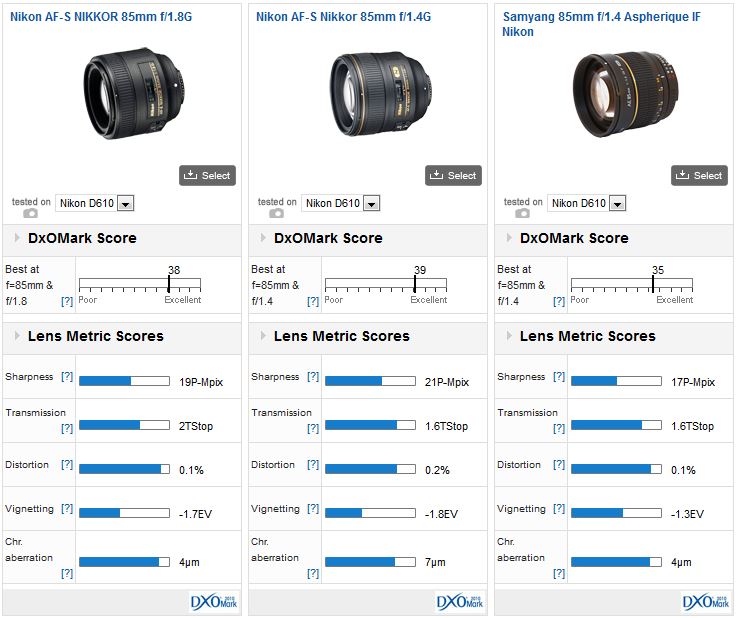
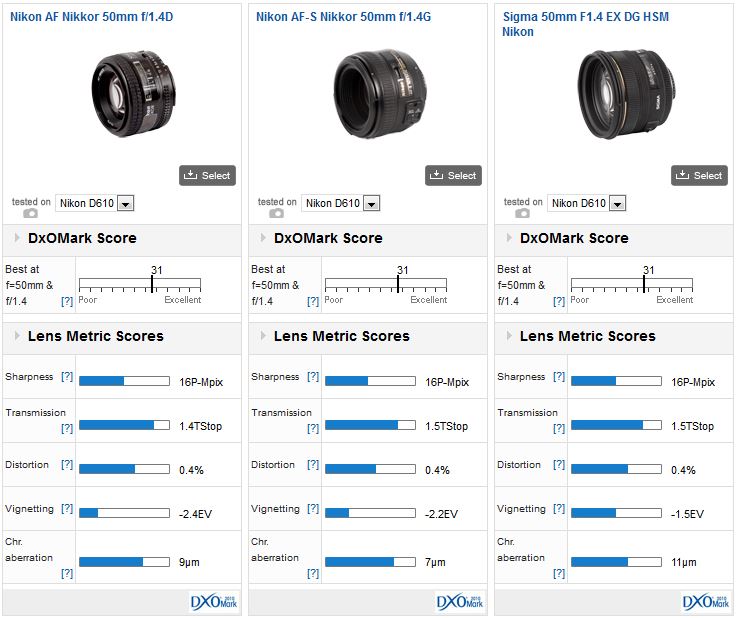
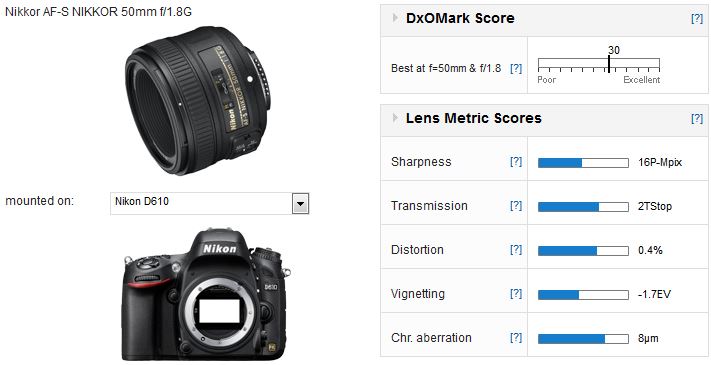
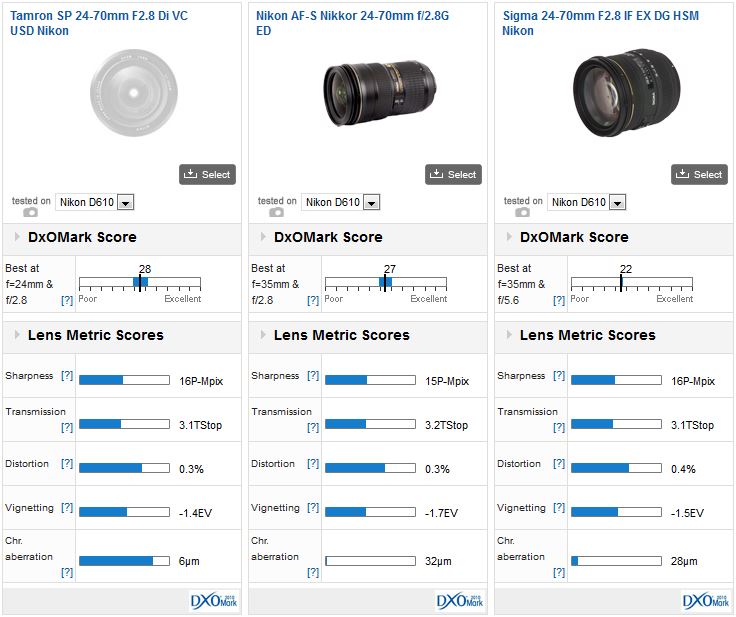
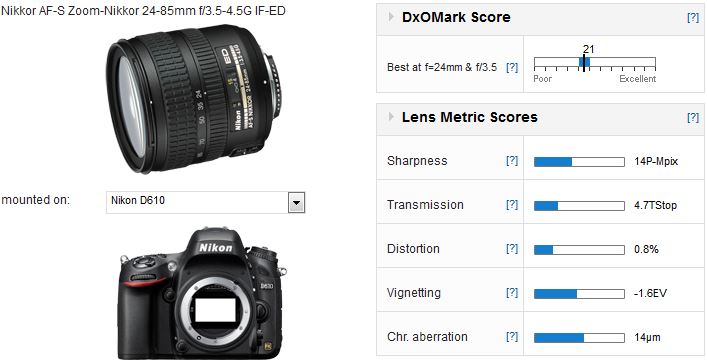
DXOMARK encourages its readers to share comments on the articles. To read or post comments, Disqus cookies are required. Change your Cookies Preferences and read more about our Comment Policy.